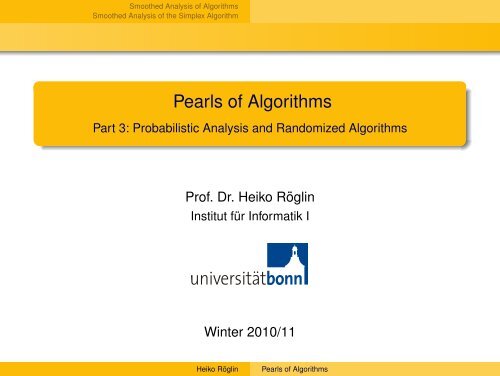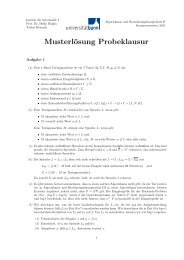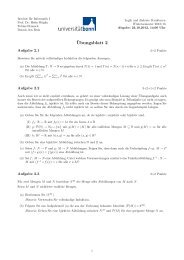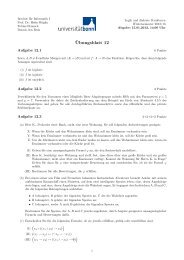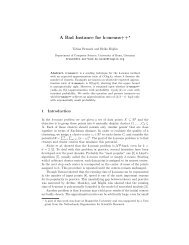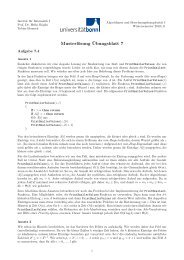Pearls of Algorithms - Heiko Röglin
Pearls of Algorithms - Heiko Röglin
Pearls of Algorithms - Heiko Röglin
You also want an ePaper? Increase the reach of your titles
YUMPU automatically turns print PDFs into web optimized ePapers that Google loves.
Smoothed Analysis <strong>of</strong> <strong>Algorithms</strong><br />
Smoothed Analysis <strong>of</strong> the Simplex Algorithm<br />
<strong>Pearls</strong> <strong>of</strong> <strong>Algorithms</strong><br />
Part 3: Probabilistic Analysis and Randomized <strong>Algorithms</strong><br />
Pr<strong>of</strong>. Dr. <strong>Heiko</strong> Röglin<br />
Institut für Informatik I<br />
Winter 2010/11<br />
<strong>Heiko</strong> Röglin<br />
<strong>Pearls</strong> <strong>of</strong> <strong>Algorithms</strong>
Smoothed Analysis <strong>of</strong> <strong>Algorithms</strong><br />
Smoothed Analysis <strong>of</strong> the Simplex Algorithm<br />
General Information<br />
information about lecture and tutorials<br />
time and location as in parts 1 and 2<br />
more information on website:<br />
www.roeglin.org/teaching/WS2010/<strong>Pearls</strong>.html<br />
information about me<br />
<strong>Heiko</strong> Röglin<br />
pr<strong>of</strong>essor <strong>of</strong> theoretical computer science<br />
main research area: probabilistic analysis <strong>of</strong> algorithms<br />
<strong>of</strong>fice hours: Tuesday, 10:00 - 11:00, and after the lectures<br />
<strong>of</strong>fice address: Brühler Straße 7, room 3.055.<br />
e-mail: roeglin@cs.uni-bonn.de<br />
<strong>Heiko</strong> Röglin<br />
<strong>Pearls</strong> <strong>of</strong> <strong>Algorithms</strong>
Smoothed Analysis <strong>of</strong> <strong>Algorithms</strong><br />
Smoothed Analysis <strong>of</strong> the Simplex Algorithm<br />
Efficient <strong>Algorithms</strong><br />
When is an algorithm considered efficient?<br />
<strong>Heiko</strong> Röglin<br />
<strong>Pearls</strong> <strong>of</strong> <strong>Algorithms</strong>
Smoothed Analysis <strong>of</strong> <strong>Algorithms</strong><br />
Smoothed Analysis <strong>of</strong> the Simplex Algorithm<br />
Efficient <strong>Algorithms</strong><br />
When is an algorithm considered efficient?<br />
Engineer<br />
The algorithm must be efficient in practice,<br />
i.e., it must solve practical instances in an<br />
appropriate amount <strong>of</strong> time.<br />
<strong>Heiko</strong> Röglin<br />
<strong>Pearls</strong> <strong>of</strong> <strong>Algorithms</strong>
Smoothed Analysis <strong>of</strong> <strong>Algorithms</strong><br />
Smoothed Analysis <strong>of</strong> the Simplex Algorithm<br />
Efficient <strong>Algorithms</strong><br />
When is an algorithm considered efficient?<br />
Engineer<br />
The algorithm must be efficient in practice,<br />
i.e., it must solve practical instances in an<br />
appropriate amount <strong>of</strong> time.<br />
Theorist<br />
The algorithm must be efficient in the worst case,<br />
i.e., it must solve all instances in polynomial time.<br />
<strong>Heiko</strong> Röglin<br />
<strong>Pearls</strong> <strong>of</strong> <strong>Algorithms</strong>
Smoothed Analysis <strong>of</strong> <strong>Algorithms</strong><br />
Smoothed Analysis <strong>of</strong> the Simplex Algorithm<br />
The Knapsack Problem<br />
Knapsack problem (KP)<br />
Input<br />
set <strong>of</strong> items {1, . . . , n}<br />
pr<strong>of</strong>its p 1 , . . . , p n<br />
weights w 1 , . . . , w n<br />
capacity b<br />
<strong>Heiko</strong> Röglin<br />
<strong>Pearls</strong> <strong>of</strong> <strong>Algorithms</strong>
Smoothed Analysis <strong>of</strong> <strong>Algorithms</strong><br />
Smoothed Analysis <strong>of</strong> the Simplex Algorithm<br />
The Knapsack Problem<br />
Knapsack problem (KP)<br />
Input<br />
set <strong>of</strong> items {1, . . . , n}<br />
pr<strong>of</strong>its p 1 , . . . , p n<br />
weights w 1 , . . . , w n<br />
capacity b<br />
Goal<br />
Find a subset <strong>of</strong> items that fits into the<br />
knapsack and maximizes the pr<strong>of</strong>it.<br />
<strong>Heiko</strong> Röglin<br />
<strong>Pearls</strong> <strong>of</strong> <strong>Algorithms</strong>
Smoothed Analysis <strong>of</strong> <strong>Algorithms</strong><br />
Smoothed Analysis <strong>of</strong> the Simplex Algorithm<br />
The Knapsack Problem<br />
Knapsack problem (KP)<br />
Input<br />
set <strong>of</strong> items {1, . . . , n}<br />
pr<strong>of</strong>its p 1 , . . . , p n<br />
weights w 1 , . . . , w n<br />
capacity b<br />
Goal<br />
Find a subset <strong>of</strong> items that fits into the<br />
knapsack and maximizes the pr<strong>of</strong>it.<br />
Formal description<br />
max p 1 x 1 + · · · + p n x n<br />
subject to w 1 x 1 + · · · + w n x n ≤ b<br />
and x i ∈ {0, 1}<br />
<strong>Heiko</strong> Röglin<br />
<strong>Pearls</strong> <strong>of</strong> <strong>Algorithms</strong>
Different Opinions<br />
Smoothed Analysis <strong>of</strong> <strong>Algorithms</strong><br />
Smoothed Analysis <strong>of</strong> the Simplex Algorithm<br />
Theorists say. . .<br />
KP is NP-hard.<br />
FPTAS exists.<br />
No efficient algorithm for KP,<br />
unless P = NP.<br />
<strong>Heiko</strong> Röglin<br />
<strong>Pearls</strong> <strong>of</strong> <strong>Algorithms</strong>
Different Opinions<br />
Smoothed Analysis <strong>of</strong> <strong>Algorithms</strong><br />
Smoothed Analysis <strong>of</strong> the Simplex Algorithm<br />
Theorists say. . .<br />
KP is NP-hard.<br />
FPTAS exists.<br />
No efficient algorithm for KP,<br />
unless P = NP.<br />
<strong>Heiko</strong> Röglin<br />
Engineers say. . .<br />
KP is easy to solve!<br />
Does not even require<br />
quadratic time.<br />
There are very good heuristics<br />
for practical instances <strong>of</strong> KP.<br />
<strong>Pearls</strong> <strong>of</strong> <strong>Algorithms</strong>
Smoothed Analysis <strong>of</strong> <strong>Algorithms</strong><br />
Smoothed Analysis <strong>of</strong> the Simplex Algorithm<br />
Reason for discrepancy<br />
Reason for discrepancy<br />
Worst-case complexity is too pessimistic!<br />
There are (artificial) worst-case instances for KP on which the<br />
heuristics are not efficient. These instances, however, do not<br />
occur in practice.<br />
This phenomenon occurs not only for KP, but also for many other<br />
problems.<br />
<strong>Heiko</strong> Röglin<br />
<strong>Pearls</strong> <strong>of</strong> <strong>Algorithms</strong>
Smoothed Analysis <strong>of</strong> <strong>Algorithms</strong><br />
Smoothed Analysis <strong>of</strong> the Simplex Algorithm<br />
Reason for discrepancy<br />
Reason for discrepancy<br />
Worst-case complexity is too pessimistic!<br />
There are (artificial) worst-case instances for KP on which the<br />
heuristics are not efficient. These instances, however, do not<br />
occur in practice.<br />
This phenomenon occurs not only for KP, but also for many other<br />
problems.<br />
How to make theory more consistent with practice?<br />
Find a more realistic performance measure.<br />
<strong>Heiko</strong> Röglin<br />
<strong>Pearls</strong> <strong>of</strong> <strong>Algorithms</strong>
Smoothed Analysis <strong>of</strong> <strong>Algorithms</strong><br />
Smoothed Analysis <strong>of</strong> the Simplex Algorithm<br />
Reason for discrepancy<br />
Reason for discrepancy<br />
Worst-case complexity is too pessimistic!<br />
There are (artificial) worst-case instances for KP on which the<br />
heuristics are not efficient. These instances, however, do not<br />
occur in practice.<br />
This phenomenon occurs not only for KP, but also for many other<br />
problems.<br />
How to make theory more consistent with practice?<br />
Find a more realistic performance measure.<br />
Average-case analysis<br />
Is it realistic to consider the average<br />
case behavior instead <strong>of</strong> the worst<br />
case behavior?<br />
<strong>Heiko</strong> Röglin<br />
<strong>Pearls</strong> <strong>of</strong> <strong>Algorithms</strong>
Smoothed Analysis <strong>of</strong> <strong>Algorithms</strong><br />
Smoothed Analysis <strong>of</strong> the Simplex Algorithm<br />
Random Inputs are not Typical<br />
Random inputs are not typical!<br />
If real-world data was random, watching TV would be very boring...<br />
<strong>Heiko</strong> Röglin<br />
<strong>Pearls</strong> <strong>of</strong> <strong>Algorithms</strong>
Smoothed Analysis <strong>of</strong> <strong>Algorithms</strong><br />
Smoothed Analysis <strong>of</strong> the Simplex Algorithm<br />
What is a typical instance?<br />
What is a typical instance?<br />
Pr<strong>of</strong>it<br />
Pr<strong>of</strong>it<br />
Weight<br />
Weight<br />
Pr<strong>of</strong>it<br />
Pr<strong>of</strong>it<br />
Weight<br />
Weight<br />
It depends very much on the concrete application. We cannot say in<br />
general what a typical instance for KP looks like.<br />
<strong>Heiko</strong> Röglin<br />
<strong>Pearls</strong> <strong>of</strong> <strong>Algorithms</strong>
Smoothed Analysis <strong>of</strong> <strong>Algorithms</strong><br />
Smoothed Analysis <strong>of</strong> the Simplex Algorithm<br />
Smoothed Analysis<br />
Pr<strong>of</strong>it<br />
Step 1:<br />
Adversary<br />
chooses input I.<br />
Pr<strong>of</strong>it<br />
Weight<br />
Pr<strong>of</strong>it<br />
Weight<br />
Pr<strong>of</strong>it<br />
Weight<br />
Weight<br />
<strong>Heiko</strong> Röglin<br />
<strong>Pearls</strong> <strong>of</strong> <strong>Algorithms</strong>
Smoothed Analysis <strong>of</strong> <strong>Algorithms</strong><br />
Smoothed Analysis <strong>of</strong> the Simplex Algorithm<br />
Smoothed Analysis<br />
Pr<strong>of</strong>it<br />
Pr<strong>of</strong>it<br />
Step 1:<br />
Adversary<br />
chooses input I.<br />
Pr<strong>of</strong>it<br />
Weight<br />
Step 2: Random<br />
perturbation.<br />
I → per(I)<br />
Pr<strong>of</strong>it<br />
Weight<br />
Weight<br />
Weight<br />
Pr<strong>of</strong>it<br />
Pr<strong>of</strong>it<br />
Weight<br />
Weight<br />
Pr<strong>of</strong>it<br />
Pr<strong>of</strong>it<br />
Weight<br />
Weight<br />
<strong>Heiko</strong> Röglin<br />
<strong>Pearls</strong> <strong>of</strong> <strong>Algorithms</strong>
Smoothed Analysis <strong>of</strong> <strong>Algorithms</strong><br />
Smoothed Analysis <strong>of</strong> the Simplex Algorithm<br />
Smoothed Analysis<br />
Step 1:<br />
Adversary<br />
chooses input I.<br />
Step 2: Random<br />
perturbation.<br />
I → per(I)<br />
Smoothed Complexity = worst expected running time the adversary<br />
can achieve<br />
Why do we consider this model?<br />
First step alone: worst case analysis.<br />
Second step models random influences, e.g., measurement<br />
errors, numerical imprecision, rounding, . . .<br />
So we have a combination <strong>of</strong> both: instances <strong>of</strong> any structure with<br />
some amount <strong>of</strong> random noise.<br />
<strong>Heiko</strong> Röglin<br />
<strong>Pearls</strong> <strong>of</strong> <strong>Algorithms</strong>
Perturbation<br />
Smoothed Analysis <strong>of</strong> <strong>Algorithms</strong><br />
Smoothed Analysis <strong>of</strong> the Simplex Algorithm<br />
Example<br />
Step 1: Adversary chooses all p i , w i ∈ [0, 1] arbitrarily.<br />
Pr<strong>of</strong>it<br />
Weight<br />
<strong>Heiko</strong> Röglin<br />
<strong>Pearls</strong> <strong>of</strong> <strong>Algorithms</strong>
Smoothed Analysis <strong>of</strong> <strong>Algorithms</strong><br />
Smoothed Analysis <strong>of</strong> the Simplex Algorithm<br />
Perturbation<br />
Example<br />
Step 1: Adversary chooses all p i , w i ∈ [0, 1] arbitrarily.<br />
Step 2: Add an independent Gaussian random variable to each<br />
pr<strong>of</strong>it and weight.<br />
Pr<strong>of</strong>it<br />
1<br />
sigma=0.5<br />
sigma=1<br />
sigma=2<br />
0.5<br />
0<br />
-5 -4 -3 -2 -1 0 1 2 3 4 5<br />
Weight<br />
<strong>Heiko</strong> Röglin<br />
<strong>Pearls</strong> <strong>of</strong> <strong>Algorithms</strong>
Smoothed Analysis <strong>of</strong> <strong>Algorithms</strong><br />
Smoothed Analysis <strong>of</strong> the Simplex Algorithm<br />
Perturbation<br />
Example<br />
Step 1: Adversary chooses all p i , w i ∈ [0, 1] arbitrarily.<br />
Step 2: Add an independent Gaussian random variable to each<br />
pr<strong>of</strong>it and weight.<br />
Pr<strong>of</strong>it<br />
1<br />
sigma=0.5<br />
sigma=1<br />
sigma=2<br />
0.5<br />
σ 1<br />
0<br />
-5 -4 -3 -2 -1 0 1 2 3 4 5<br />
Weight<br />
<strong>Heiko</strong> Röglin<br />
<strong>Pearls</strong> <strong>of</strong> <strong>Algorithms</strong>
Smoothed Analysis <strong>of</strong> <strong>Algorithms</strong><br />
Smoothed Analysis <strong>of</strong> the Simplex Algorithm<br />
Perturbation<br />
Example<br />
Step 1: Adversary chooses all p i , w i ∈ [0, 1] arbitrarily.<br />
Step 2: Add an independent Gaussian random variable to each<br />
pr<strong>of</strong>it and weight.<br />
Pr<strong>of</strong>it<br />
1<br />
sigma=0.5<br />
sigma=1<br />
sigma=2<br />
0.5<br />
σ 1 > σ 2<br />
0<br />
-5 -4 -3 -2 -1 0 1 2 3 4 5<br />
Weight<br />
<strong>Heiko</strong> Röglin<br />
<strong>Pearls</strong> <strong>of</strong> <strong>Algorithms</strong>
Smoothed Analysis <strong>of</strong> <strong>Algorithms</strong><br />
Smoothed Analysis <strong>of</strong> the Simplex Algorithm<br />
Complexity Measures<br />
C A(I)<br />
Instances <strong>of</strong> length n.<br />
C A (I) = running time <strong>of</strong> algorithm A on input I<br />
X n = set <strong>of</strong> inputs <strong>of</strong> length n,<br />
<strong>Heiko</strong> Röglin<br />
<strong>Pearls</strong> <strong>of</strong> <strong>Algorithms</strong>
Smoothed Analysis <strong>of</strong> <strong>Algorithms</strong><br />
Smoothed Analysis <strong>of</strong> the Simplex Algorithm<br />
Complexity Measures<br />
C A(I)<br />
CA<br />
worst (n)<br />
Instances <strong>of</strong> length n.<br />
C A (I) = running time <strong>of</strong> algorithm A on input I<br />
X n = set <strong>of</strong> inputs <strong>of</strong> length n,<br />
CA<br />
worst (n) = max I∈Xn (C A (I))<br />
<strong>Heiko</strong> Röglin<br />
<strong>Pearls</strong> <strong>of</strong> <strong>Algorithms</strong>
Smoothed Analysis <strong>of</strong> <strong>Algorithms</strong><br />
Smoothed Analysis <strong>of</strong> the Simplex Algorithm<br />
Complexity Measures<br />
C A(I)<br />
CA<br />
worst (n)<br />
CA<br />
ave (n)<br />
Instances <strong>of</strong> length n.<br />
C A (I) = running time <strong>of</strong> algorithm A on input I<br />
X n = set <strong>of</strong> inputs <strong>of</strong> length n, µ n = prob. distribution on X n<br />
CA<br />
worst (n) = max I∈Xn (C A (I))<br />
CA ave(n)<br />
= E I ← µn X n<br />
[C A (I)]<br />
<strong>Heiko</strong> Röglin<br />
<strong>Pearls</strong> <strong>of</strong> <strong>Algorithms</strong>
Smoothed Analysis <strong>of</strong> <strong>Algorithms</strong><br />
Smoothed Analysis <strong>of</strong> the Simplex Algorithm<br />
Complexity Measures<br />
C A(I)<br />
CA<br />
worst (n)<br />
C smooth<br />
A (n, σ 2)<br />
σ 2 < σ 1<br />
C smooth<br />
A (n, σ 1)<br />
CA<br />
ave (n)<br />
I<br />
Instances <strong>of</strong> length n.<br />
C A (I) = running time <strong>of</strong> algorithm A on input I<br />
X n = set <strong>of</strong> inputs <strong>of</strong> length n, µ n = prob. distribution on X n<br />
CA<br />
worst (n) = max I∈Xn (C A (I))<br />
CA ave(n)<br />
= E I ← µn X n<br />
[C A (I)]<br />
C smooth<br />
A<br />
(n, σ) = max I∈Xn E[C A (per σ (I))]<br />
<strong>Heiko</strong> Röglin<br />
<strong>Pearls</strong> <strong>of</strong> <strong>Algorithms</strong>
Smoothed Analysis <strong>of</strong> <strong>Algorithms</strong><br />
Smoothed Analysis <strong>of</strong> the Simplex Algorithm<br />
Complexity Measures<br />
C A(I)<br />
CA<br />
worst (n)<br />
C smooth<br />
A (n, σ 2)<br />
σ 2 < σ 1<br />
C smooth<br />
A (n, σ 1)<br />
CA<br />
ave (n)<br />
I<br />
Instances <strong>of</strong> length n.<br />
C A (I) = running time <strong>of</strong> algorithm A on input I<br />
X n = set <strong>of</strong> inputs <strong>of</strong> length n, µ n = prob. distribution on X n<br />
CA<br />
worst (n) = max I∈Xn (C A (I))<br />
CA ave(n)<br />
= E I ← µn X n<br />
[C A (I)]<br />
CA<br />
smooth (n, σ) = max I∈Xn E[C A (per σ (I))]<br />
smoothed complexity low ⇒ bad instances are isolated peaks<br />
<strong>Heiko</strong> Röglin<br />
<strong>Pearls</strong> <strong>of</strong> <strong>Algorithms</strong>
Linear Programs<br />
Smoothed Analysis <strong>of</strong> <strong>Algorithms</strong><br />
Smoothed Analysis <strong>of</strong> the Simplex Algorithm<br />
Linear Programs (LPs)<br />
variables: x 1 , . . . , x d ∈ R.<br />
linear objective function:<br />
max c 1 x 1 + . . . + c n x n .<br />
<strong>Heiko</strong> Röglin<br />
<strong>Pearls</strong> <strong>of</strong> <strong>Algorithms</strong>
Linear Programs<br />
Smoothed Analysis <strong>of</strong> <strong>Algorithms</strong><br />
Smoothed Analysis <strong>of</strong> the Simplex Algorithm<br />
Linear Programs (LPs)<br />
c<br />
variables: x 1 , . . . , x d ∈ R.<br />
a n,1 x 1 + . . . + a n,d x d ≤ b n<br />
linear objective function:<br />
max c 1 x 1 + . . . + c n x n .<br />
n linear constraints:<br />
x ∗<br />
a 1,1 x 1 + . . . + a 1,d x d ≤ b 1<br />
.<br />
<strong>Heiko</strong> Röglin<br />
<strong>Pearls</strong> <strong>of</strong> <strong>Algorithms</strong>
Linear Programs<br />
Smoothed Analysis <strong>of</strong> <strong>Algorithms</strong><br />
Smoothed Analysis <strong>of</strong> the Simplex Algorithm<br />
Linear Programs (LPs)<br />
c<br />
variables: x 1 , . . . , x d ∈ R.<br />
a n,1 x 1 + . . . + a n,d x d ≤ b n<br />
linear objective function:<br />
max c 1 x 1 + . . . + c n x n .<br />
n linear constraints:<br />
x ∗<br />
a 1,1 x 1 + . . . + a 1,d x d ≤ b 1<br />
.<br />
Complexity <strong>of</strong> LPs<br />
LPs can be solved in polynomial time by the ellipsoid method<br />
[Khachiyan 1979].<br />
<strong>Heiko</strong> Röglin<br />
<strong>Pearls</strong> <strong>of</strong> <strong>Algorithms</strong>
Simplex Algorithm<br />
Smoothed Analysis <strong>of</strong> <strong>Algorithms</strong><br />
Smoothed Analysis <strong>of</strong> the Simplex Algorithm<br />
c<br />
Simplex Algorithm<br />
The simplex method walks<br />
along the vertices <strong>of</strong> the<br />
polytope in the direction <strong>of</strong><br />
the objective function c T x.<br />
<strong>Heiko</strong> Röglin<br />
<strong>Pearls</strong> <strong>of</strong> <strong>Algorithms</strong>
Simplex Algorithm<br />
Smoothed Analysis <strong>of</strong> <strong>Algorithms</strong><br />
Smoothed Analysis <strong>of</strong> the Simplex Algorithm<br />
c<br />
Simplex Algorithm<br />
The simplex method walks<br />
along the vertices <strong>of</strong> the<br />
polytope in the direction <strong>of</strong><br />
the objective function c T x.<br />
<strong>Heiko</strong> Röglin<br />
<strong>Pearls</strong> <strong>of</strong> <strong>Algorithms</strong>
Simplex Algorithm<br />
Smoothed Analysis <strong>of</strong> <strong>Algorithms</strong><br />
Smoothed Analysis <strong>of</strong> the Simplex Algorithm<br />
c<br />
Simplex Algorithm<br />
The simplex method walks<br />
along the vertices <strong>of</strong> the<br />
polytope in the direction <strong>of</strong><br />
the objective function c T x.<br />
<strong>Heiko</strong> Röglin<br />
<strong>Pearls</strong> <strong>of</strong> <strong>Algorithms</strong>
Simplex Algorithm<br />
Smoothed Analysis <strong>of</strong> <strong>Algorithms</strong><br />
Smoothed Analysis <strong>of</strong> the Simplex Algorithm<br />
c<br />
Simplex Algorithm<br />
The simplex method walks<br />
along the vertices <strong>of</strong> the<br />
polytope in the direction <strong>of</strong><br />
the objective function c T x.<br />
<strong>Heiko</strong> Röglin<br />
<strong>Pearls</strong> <strong>of</strong> <strong>Algorithms</strong>
Simplex Algorithm<br />
Smoothed Analysis <strong>of</strong> <strong>Algorithms</strong><br />
Smoothed Analysis <strong>of</strong> the Simplex Algorithm<br />
c<br />
Simplex Algorithm<br />
The simplex method walks<br />
along the vertices <strong>of</strong> the<br />
polytope in the direction <strong>of</strong><br />
the objective function c T x.<br />
Exponential in the worst<br />
case.<br />
Works well in practice.<br />
<strong>Heiko</strong> Röglin<br />
<strong>Pearls</strong> <strong>of</strong> <strong>Algorithms</strong>
Pivot Rules<br />
Smoothed Analysis <strong>of</strong> <strong>Algorithms</strong><br />
Smoothed Analysis <strong>of</strong> the Simplex Algorithm<br />
c<br />
Pivot Rules<br />
How is a better vertex on the<br />
polytope chosen if there are multiple<br />
options?<br />
Different pivot rules have been<br />
suggested:<br />
random<br />
steepest descent<br />
shadow vertex pivot rule<br />
. . .<br />
<strong>Heiko</strong> Röglin<br />
<strong>Pearls</strong> <strong>of</strong> <strong>Algorithms</strong>
Smoothed Analysis <strong>of</strong> <strong>Algorithms</strong><br />
Smoothed Analysis <strong>of</strong> the Simplex Algorithm<br />
Shadow Vertex Pivot Rule<br />
Shadow Vertex Pivot Rule<br />
Let x 0 be some vertex <strong>of</strong><br />
the polytope.<br />
Compute u ∈ R d such that<br />
x 0 maximizes u T x.<br />
u<br />
c<br />
<strong>Heiko</strong> Röglin<br />
<strong>Pearls</strong> <strong>of</strong> <strong>Algorithms</strong>
Smoothed Analysis <strong>of</strong> <strong>Algorithms</strong><br />
Smoothed Analysis <strong>of</strong> the Simplex Algorithm<br />
Shadow Vertex Pivot Rule<br />
Shadow Vertex Pivot Rule<br />
Let x 0 be some vertex <strong>of</strong><br />
the polytope.<br />
Compute u ∈ R d such that<br />
x 0 maximizes u T x.<br />
Project the polytope onto<br />
the plane spanned by c<br />
and u.<br />
u<br />
c<br />
<strong>Heiko</strong> Röglin<br />
<strong>Pearls</strong> <strong>of</strong> <strong>Algorithms</strong>
Smoothed Analysis <strong>of</strong> <strong>Algorithms</strong><br />
Smoothed Analysis <strong>of</strong> the Simplex Algorithm<br />
Shadow Vertex Pivot Rule<br />
2-dimensional projection<br />
The projection is 2-dimensional,<br />
that is, a polygon.<br />
c<br />
u<br />
<strong>Heiko</strong> Röglin<br />
<strong>Pearls</strong> <strong>of</strong> <strong>Algorithms</strong>
Smoothed Analysis <strong>of</strong> <strong>Algorithms</strong><br />
Smoothed Analysis <strong>of</strong> the Simplex Algorithm<br />
Shadow Vertex Pivot Rule<br />
2-dimensional projection<br />
The projection is 2-dimensional,<br />
that is, a polygon.<br />
x 0 is a vertex <strong>of</strong> the polygon.<br />
c<br />
x 0<br />
u<br />
<strong>Heiko</strong> Röglin<br />
<strong>Pearls</strong> <strong>of</strong> <strong>Algorithms</strong>
Smoothed Analysis <strong>of</strong> <strong>Algorithms</strong><br />
Smoothed Analysis <strong>of</strong> the Simplex Algorithm<br />
Shadow Vertex Pivot Rule<br />
x opt<br />
x 0<br />
2-dimensional projection<br />
The projection is 2-dimensional,<br />
that is, a polygon.<br />
x 0 is a vertex <strong>of</strong> the polygon.<br />
x opt is a vertex <strong>of</strong> the polygon.<br />
c<br />
u<br />
<strong>Heiko</strong> Röglin<br />
<strong>Pearls</strong> <strong>of</strong> <strong>Algorithms</strong>
Smoothed Analysis <strong>of</strong> <strong>Algorithms</strong><br />
Smoothed Analysis <strong>of</strong> the Simplex Algorithm<br />
Shadow Vertex Pivot Rule<br />
2-dimensional projection<br />
The projection is 2-dimensional,<br />
that is, a polygon.<br />
x 0 is a vertex <strong>of</strong> the polygon.<br />
x opt is a vertex <strong>of</strong> the polygon.<br />
Edges <strong>of</strong> the polygon correspond<br />
to edges <strong>of</strong> the polytope.<br />
c<br />
x opt<br />
x 0<br />
u<br />
<strong>Heiko</strong> Röglin<br />
<strong>Pearls</strong> <strong>of</strong> <strong>Algorithms</strong>
Smoothed Analysis <strong>of</strong> <strong>Algorithms</strong><br />
Smoothed Analysis <strong>of</strong> the Simplex Algorithm<br />
Shadow Vertex Pivot Rule<br />
2-dimensional projection<br />
In 2 dimension the simplex<br />
method is easy; it just follows the<br />
edges <strong>of</strong> the polygon.<br />
c<br />
x opt<br />
x 0<br />
u<br />
<strong>Heiko</strong> Röglin<br />
<strong>Pearls</strong> <strong>of</strong> <strong>Algorithms</strong>
Smoothed Analysis <strong>of</strong> <strong>Algorithms</strong><br />
Smoothed Analysis <strong>of</strong> the Simplex Algorithm<br />
Shadow Vertex Pivot Rule<br />
2-dimensional projection<br />
In 2 dimension the simplex<br />
method is easy; it just follows the<br />
edges <strong>of</strong> the polygon.<br />
It starts at x 0 ...<br />
c<br />
x opt<br />
x 0<br />
u<br />
<strong>Heiko</strong> Röglin<br />
<strong>Pearls</strong> <strong>of</strong> <strong>Algorithms</strong>
Smoothed Analysis <strong>of</strong> <strong>Algorithms</strong><br />
Smoothed Analysis <strong>of</strong> the Simplex Algorithm<br />
Shadow Vertex Pivot Rule<br />
2-dimensional projection<br />
In 2 dimension the simplex<br />
method is easy; it just follows the<br />
edges <strong>of</strong> the polygon.<br />
It starts at x 0 ...<br />
... and follows the edges to x opt .<br />
c<br />
x opt<br />
x 0<br />
u<br />
<strong>Heiko</strong> Röglin<br />
<strong>Pearls</strong> <strong>of</strong> <strong>Algorithms</strong>
Smoothed Analysis <strong>of</strong> <strong>Algorithms</strong><br />
Smoothed Analysis <strong>of</strong> the Simplex Algorithm<br />
Shadow Vertex Pivot Rule<br />
2-dimensional projection<br />
In 2 dimension the simplex<br />
method is easy; it just follows the<br />
edges <strong>of</strong> the polygon.<br />
It starts at x 0 ...<br />
... and follows the edges to x opt .<br />
c<br />
x opt<br />
x 0<br />
u<br />
<strong>Heiko</strong> Röglin<br />
<strong>Pearls</strong> <strong>of</strong> <strong>Algorithms</strong>
Smoothed Analysis <strong>of</strong> <strong>Algorithms</strong><br />
Smoothed Analysis <strong>of</strong> the Simplex Algorithm<br />
Shadow Vertex Pivot Rule<br />
2-dimensional projection<br />
In 2 dimension the simplex<br />
method is easy; it just follows the<br />
edges <strong>of</strong> the polygon.<br />
It starts at x 0 ...<br />
... and follows the edges to x opt .<br />
The polygon can have an<br />
exponential number <strong>of</strong> edges.<br />
c<br />
x opt<br />
x 0<br />
u<br />
<strong>Heiko</strong> Röglin<br />
<strong>Pearls</strong> <strong>of</strong> <strong>Algorithms</strong>
Smoothed Analysis <strong>of</strong> <strong>Algorithms</strong><br />
Smoothed Analysis <strong>of</strong> the Simplex Algorithm<br />
Perturbed Linear Programs<br />
Perturbed LPs<br />
Step 1: Adversary specifies arbitrary LP:<br />
max c T x subject to a T 1 x ≤ b 1 . . . a T n x ≤ b n.<br />
W. l. o. g. ‖(a i , b i )‖ = 1.<br />
<strong>Heiko</strong> Röglin<br />
<strong>Pearls</strong> <strong>of</strong> <strong>Algorithms</strong>
Smoothed Analysis <strong>of</strong> <strong>Algorithms</strong><br />
Smoothed Analysis <strong>of</strong> the Simplex Algorithm<br />
Perturbed Linear Programs<br />
Perturbed LPs<br />
Step 1: Adversary specifies arbitrary LP:<br />
max c T x subject to a T 1 x ≤ b 1 . . . a T n x ≤ b n.<br />
W. l. o. g. ‖(a i , b i )‖ = 1.<br />
Step 2: Add Gaussian random variable with standard deviation σ<br />
to each coefficient in the constraints.<br />
<strong>Heiko</strong> Röglin<br />
<strong>Pearls</strong> <strong>of</strong> <strong>Algorithms</strong>
Smoothed Analysis <strong>of</strong> <strong>Algorithms</strong><br />
Smoothed Analysis <strong>of</strong> the Simplex Algorithm<br />
Smoothed Analysis <strong>of</strong> the Simplex Algorithm<br />
Theorem [Spielman and Teng 2001]<br />
The expected number <strong>of</strong> edges on the polygon is<br />
O ( poly ( n, d, σ −1)) .<br />
<strong>Heiko</strong> Röglin<br />
<strong>Pearls</strong> <strong>of</strong> <strong>Algorithms</strong>
Smoothed Analysis <strong>of</strong> <strong>Algorithms</strong><br />
Smoothed Analysis <strong>of</strong> the Simplex Algorithm<br />
Smoothed Analysis <strong>of</strong> the Simplex Algorithm<br />
Theorem [Spielman and Teng 2001]<br />
The expected number <strong>of</strong> edges on the polygon is<br />
O ( poly ( n, d, σ −1)) .<br />
The smoothed running time <strong>of</strong> the simplex algorithm with shadow<br />
vertex pivot rule is<br />
O ( poly ( n, d, σ −1)) .<br />
<strong>Heiko</strong> Röglin<br />
<strong>Pearls</strong> <strong>of</strong> <strong>Algorithms</strong>
Smoothed Analysis <strong>of</strong> <strong>Algorithms</strong><br />
Smoothed Analysis <strong>of</strong> the Simplex Algorithm<br />
Smoothed Analysis <strong>of</strong> the Simplex Algorithm<br />
Theorem [Spielman and Teng 2001]<br />
The expected number <strong>of</strong> edges on the polygon is<br />
O ( poly ( n, d, σ −1)) .<br />
The smoothed running time <strong>of</strong> the simplex algorithm with shadow<br />
vertex pivot rule is<br />
O ( poly ( n, d, σ −1)) .<br />
Running time is polynomial in n, d, and σ −1 .<br />
Already for small perturbation it is extremely unlikely to hit a bad<br />
instance.<br />
<strong>Heiko</strong> Röglin<br />
<strong>Pearls</strong> <strong>of</strong> <strong>Algorithms</strong>
Improved Analysis<br />
Smoothed Analysis <strong>of</strong> <strong>Algorithms</strong><br />
Smoothed Analysis <strong>of</strong> the Simplex Algorithm<br />
Theorem [Vershynin 2006]<br />
The smoothed running time <strong>of</strong> the simplex algorithm with shadow<br />
vertex pivot rule is<br />
O ( poly ( log n, d, σ −1)) .<br />
Running time is only polylogarithmic in the number <strong>of</strong> constraints n.<br />
<strong>Heiko</strong> Röglin<br />
<strong>Pearls</strong> <strong>of</strong> <strong>Algorithms</strong>
Smoothed Analysis <strong>of</strong> <strong>Algorithms</strong><br />
Smoothed Analysis <strong>of</strong> the Simplex Algorithm<br />
Overview <strong>of</strong> the coming Lectures<br />
Smoothed Analysis<br />
Nemhauser/Ullmann algorithm for the knapsack problem<br />
2-Opt heuristic for the traveling salesperson problem<br />
k-means clustering<br />
Randomized <strong>Algorithms</strong><br />
k-means++<br />
. . .<br />
<strong>Heiko</strong> Röglin<br />
<strong>Pearls</strong> <strong>of</strong> <strong>Algorithms</strong>


